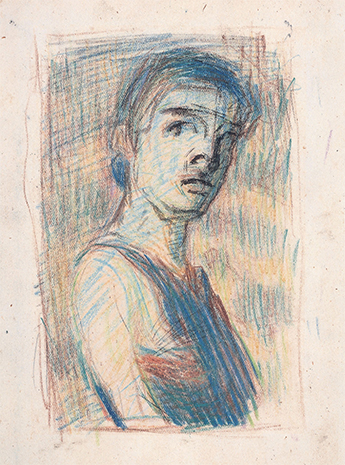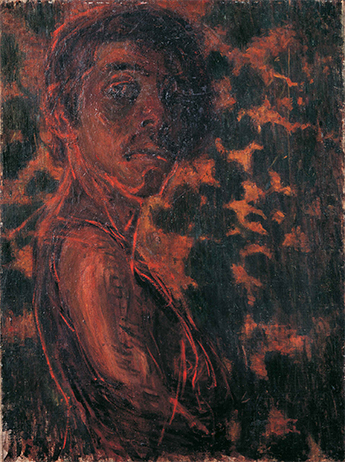Curators’ selection — Hidden Masterpieces
NAKAMURA Hochu, Flowers and Plants of the Four Seasons, Edo period, Early 19th century, Color on paper
NAKAMURA Hochu, Flowers and Plants of the Four Seasons, Edo period, Early 19th century, Color on paper
Aman’s face floats up palely from the darkness. Is it a dream or reality—or is it phantom? The lines in colored pencil, applied over each other as though in a messy trial drawing, the image of the face suddenly leaping out from the paper--paper that a moment before had seemed inconsequential—one cannot help staring, as though at a mirage that had emerged from an utterly alien space. The diagonal lines applied as though to envelope the face and the pale reds skillfully create darkness. The contrast between light and darkness makes the face stand out.
This drawing is a student-period work by Aoki Shigeru (1882-1911), a Meiji artist who has continued to enthrall his admirers, not only because of the appeal of his work itself but also for many nearly legendary episodes from his life. In 1903, while a student at the Tokyo Fine Arts School (now Tokyo University of the Arts), Aoki showed over ten paintings on mythological themes, including Yomotsuhirasaka, at the eighth Hakubakai Exhibition, which was organized by Kuroda Seiki and others. At that exhibition, his debut in the art world, he won the top prize, the Hakuba Award. He then attracted even more interest when he exhibited A Gift of the Sea, among other works, at the next year’s Hakubakai Exhibition.
Face dates from the period in which Aoki was beginning to be recognized in the art world. At the time, Aoki was interested in the effects produced with colored pencils and in color schemes and contrasts between dark and light. He was also pursuing fantastic or illusory effects. Placing, side by side, lines made with colored pencils—light blue, blue, brown, pink, yellow—and overlapping them: other studies exist from the same period when Aoki was probing color combinations. In addition, in Yomotsuhirasaka (Tokyo University of the Arts collection), one of the debut works that rocketed Aoki to fame, he used colored pencils as well as watercolors and pastels, depicting the dark underworld of the dead and the brightly lit world of the present, the darkness and the human beings, with blues and yellows as his basic palette. Some ridiculed that group of paintings on mythological subjects as “demon paintings,” while others praised them as mystical, as Masamune Tokusaburo, a somewhat younger artist, has said.* Colored pencils played a major role in Aoki’s distinctive expressive techniques, which some regard as mystical or unfathomable.
In addition to Face, our museum owns Self-Portrait (fig.1), another work in colored pencils with the face as the subject that Aoki created in the same year. It is a preparatory drawing for his Self-Portrait (fig.2) in oils. The background covered with small patches of colors, the shadows in which faces and bodies are visible: in Self-Portrait, the palette based on blue and green, as in Yomotsuhirasaka and Face, and the contracts between light and dark are expressed in a different form.
Face, which was created on a rather small sheet of paper, 15 centimeters on a side, is not a striking presence. By considering it in conjunction with Aoki’s other work from the same period, his color combinations and contrasts between dark and light, however, we can trace Aoki’s groping for a means of expression in the colored pencil techniques he used in his early work. Kawakita Michiaki used Face as the frontispiece in his Aoki Shigeru: Life and Work (Yotokusha, 1948), which calls attention to Aoki’s position in art history.

- fig.1
- AOKI Shigeru, Self-Portrait, 1903, Colored pencil on paper

- fig.2
- AOKI Shigeru, Self-Portrait, 1903, Oil on canvas
-
Emile GALLE, Vase, decorated with dragonfly and flower design, c. 1880-1900
-
KAWAKAMI Ryoka, Early Summer, 1919, Oil on canvas
-
NAKAMURA Hochu, Flowers and Plants of the Four Seasons, Edo period, Early 19th century, Color on paper